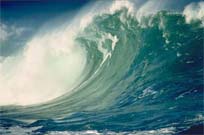Tsunami might have wiped off prehistoric village in Austrian Alps
 Berlin, Oct 12 : A geologist has found evidence that a vast rock slide may have set off a tsunami that buried a prehistoric village on Lake Mondsee in the Austrian Alps.
Berlin, Oct 12 : A geologist has found evidence that a vast rock slide may have set off a tsunami that buried a prehistoric village on Lake Mondsee in the Austrian Alps.
According to a report in Spiegel Online, the theory that a severe rockslide in the Alps destroyed a prehistoric village, has been put forward by Alexander Binsteiner, a geologist and flint stone expert.
Binsteiner believes that the accident affected lake dwellers living on the eastern tip of Mondsee Lake, near present-day Salzburg. Twenty to 50 wooden huts, coated with mud or cow dung, stood there on stilts along the lakefront.
Similar lakeside settlements were common in the fourth millennium B. C. These collections of slightly elevated huts on moist ground were scattered around the Alps, from Lake Paladru in France, across the lakes of Switzerland and Austria to Slovenia and Lake Garda in present-day Italy.
The people of the Mondsee Lake settlement were apparently relatively advanced within this cultural group.
They had metallurgical skills, which were rare in Europe. They cleverly searched the mountains for copper deposits, melted the crude ore in clay ovens and made refined, shimmering red weapons out of the metal.
At approximately 3200 B. C., according to Binsteiner, the master blacksmiths were struck by a "devastating natural disaster."
The event began with a muffled cracking noise. Then a cliff 150 meters (492-foot) tall and five kilometers (3.1 miles) long broke off on the southern shore of Mondsee Lake and plunged into the water.
The geological traces of the disaster were discovered by accident, and only recently. "A heavy storm knocked down hundreds of trees here recently," explained Binsteiner. The forest floor was thus exposed for all to see.
The root systems of the trees jut high in to the air and, more importantly, it is now apparent that the site is littered with large boulders, extending all the way down to the water''s edge.
After weeks spent examining the fracture zone, Binsteiner submitted a report of his findings.
He estimates that the fractured cliff consisted of "50 million cubic meters" of rock, and that an ensuing tsunami at least five meters (16 feet) tall rushed against the opposite shore, inundating the settlement there.
According to Helmut Schlichtherle, Germany''s leading expert on lakeside settlements, Binsteiner''s theory of an "Alpine tsunami" is "very exciting."
Erwin Ruprechtsberger, an archeologist in the Austrian city of Linz who specializes in the region, calls the cliff collapse idea "a completely new approach that could solve many of the mysteries of the Mondsee culture." (ANI)